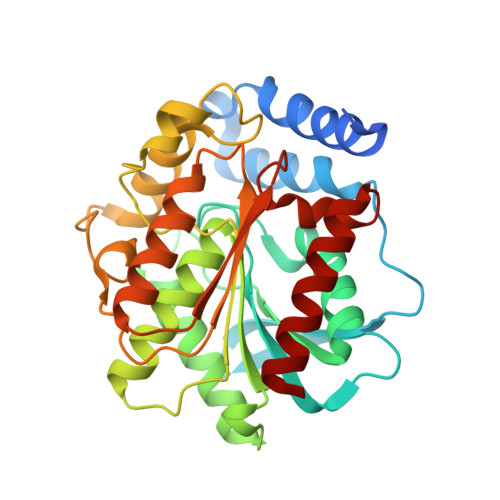Structural and Mechanistic Insights into the Improvement of the Halotolerance of a Marine Microbial Esterase by Increasing Intra- and Interdomain Hydrophobic Interactions.
Li, P.Y., Zhang, Y., Xie, B.B., Zhang, Y.Q., Hao, J., Wang, Y., Wang, P., Li, C.Y., Qin, Q.L., Zhang, X.Y., Su, H.N., Shi, M., Zhang, Y.Z., Chen, X.L.(2017) Appl Environ Microbiol 83
- PubMed: 28733281
- DOI: https://doi.org/10.1128/AEM.01286-17
- Primary Citation of Related Structures:
5GMR, 5GMS - PubMed Abstract:
Halotolerant enzymes are beneficial for industrial processes requiring high salt concentrations and low water activity. Most halophilic proteins are evolved to have reduced hydrophobic interactions on the surface and in the hydrophobic cores for their haloadaptation. However, in this study, we improved the halotolerance of a thermolabile esterase, E40, by increasing intraprotein hydrophobic interactions. E40 was quite unstable in buffers containing more than 0.3 M NaCl, and its k cat and substrate affinity were both significantly reduced in 0.5 M NaCl. By introducing hydrophobic residues in loop 1 of the CAP domain and/or α7 of the catalytic domain in E40, we obtained several mutants with improved halotolerance, and the M3 S202W I203F mutant was the most halotolerant. ("M3" represents a mutation in loop 1 of the CAP domain in which residues R22-K23-T24 of E40 are replaced by residues Y22-K23-H24-L25-S26 of Est2.) Then we solved the crystal structures of the S202W I203F and M3 S202W I203F mutants to reveal the structural basis for their improved halotolerance. Structural analysis revealed that the introduction of hydrophobic residues W202 and F203 in α7 significantly improved E40 halotolerance by strengthening intradomain hydrophobic interactions of F203 with W202 and other residues in the catalytic domain. By further introducing hydrophobic residues in loop 1, the M3 S202W I203F mutant became more rigid and halotolerant due to the formation of additional interdomain hydrophobic interactions between the introduced Y22 in loop 1 and W204 in α7. These results indicate that increasing intraprotein hydrophobic interactions is also a way to improve the halotolerance of enzymes with industrial potential under high-salt conditions. IMPORTANCE Esterases and lipases for industrial application are often subjected to harsh conditions such as high salt concentrations, low water activity, and the presence of organic solvents. However, reports on halotolerant esterases and lipases are limited, and the underlying mechanism for their halotolerance is still unclear due to the lack of structures. In this study, we focused on the improvement of the halotolerance of a salt-sensitive esterase, E40, and the underlying mechanism. The halotolerance of E40 was significantly improved by introducing hydrophobic residues. Comparative structural analysis of E40 and its halotolerant mutants revealed that increased intraprotein hydrophobic interactions make these mutants more rigid and more stable than the wild type against high concentrations of salts. This study shows a new way to improve enzyme halotolerance, which is helpful for protein engineering of salt-sensitive enzymes.
Organizational Affiliation:
Institute of Marine Science and Technology, State Key Laboratory of Microbial Technology, Shandong University, Jinan, China.














